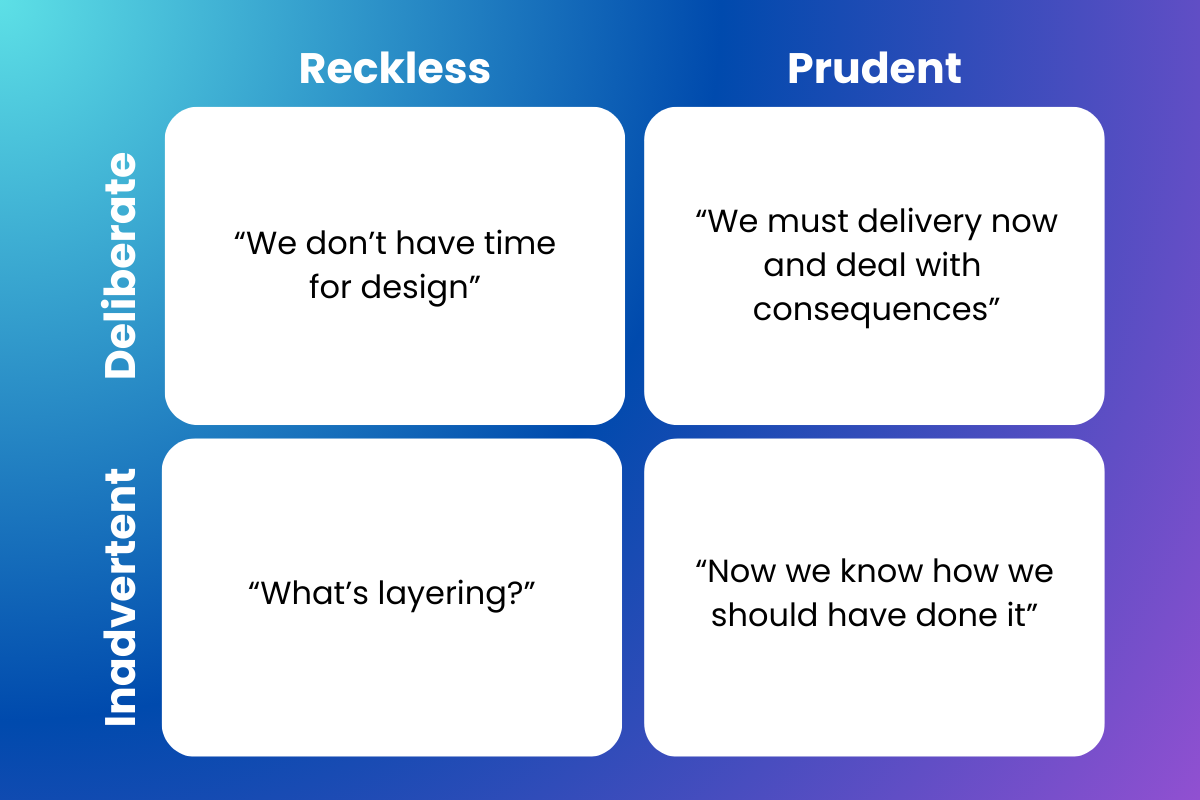Recent surveys show that organizations spend between 23% and 42% of their development efforts addressing technical debt, significantly affecting their budgets and financial performance. A McKinsey study highlights a company that estimates tech debt costs amount to 15%-60% of every dollar spent on IT, which isn’t factored into their business cases. Similarly, the study mentions a large bank that estimates its 1,000 systems and applications generate over $2 billion in tech-debt costs. Companies must understand and evaluate the impact of technical debt before deciding how to tackle it effectively.
What is Technical Debt?
In software development, technical debt refers to the additional work that needs to be done to an IT system due to shortcuts or compromises made during development to meet deadlines. This “debt” is a normal and inevitable part of software engineering. When teams prioritize speed over quality, they often cut corners or implement temporary solutions, which can lead to the software straying from its intended nonfunctional requirements. Over time, these compromises can affect the system’s performance, scalability, and resilience.
Technical debt also accumulates when regular maintenance is postponed. If this debt reaches a critical level, the software may become unstable, leading to customer dissatisfaction and significantly higher support costs, especially as the software or its infrastructure nears the end of its lifecycle.
Examples of technical debt
The Year 2000 (Y2K) Problem
The Year 2000 (Y2K) issue is a well-known example of technical debt. In the 1960s and 1970s, many software developers saved memory by storing years as two digits instead of four (e.g., “73” for 1973). This practice continued even as memory costs decreased, and many programs remained used far longer than anticipated. As the year 2000 approached, businesses and government agencies realized that these date calculations would fail, leading to a massive and costly remediation effort estimated at $100 billion.
Cybersecurity Practices
Technical debt isn’t limited to software coding practices. In cybersecurity, a standard best practice is to assign file permissions based on roles rather than individuals. If an administrative assistant is temporarily granted access to sensitive documents but the IT department fails to revoke this access afterward, it results in permanent, unauthorized access to sensitive information. This lapse can lead to security vulnerabilities if the account is compromised.
These examples illustrate how technical debt, whether in software development or cybersecurity practices, can lead to significant long-term costs and challenges if not properly managed.
Types of Technical Debt
Technical debt manifests in various forms, and there are two main approaches to classifying it:
Intentional vs. Unintentional Technical Debt
Steve McConnell, a noted author of software engineering textbooks, categorizes technical debt into two types:
Intentional Technical Debt: This occurs when development teams deliberately take shortcuts or make compromises to speed up development and meet urgent business needs.
Unintentional Technical Debt: This results from poor development practices or cutting corners, often due to a lack of knowledge or resources, leading to suboptimal outcomes.

The Technical Debt Quadrant
Martin Fowler, a respected software developer and author, proposes a more nuanced classification with his “Technical Debt Quadrant.” This model categorizes technical debt based on context and intent:
- Deliberate and Prudent: Taking calculated shortcuts with a clear plan to address them later.
- Deliberate and Reckless: Knowingly making poor decisions without a plan to resolve them.
- Inadvertent and Prudent: Accumulating debt unintentionally but with an understanding of how to fix it.
- Inadvertent and Reckless: Unknowingly accruing debt due to lack of awareness or competence, with no strategy for resolution.
These classifications help teams understand the nature of their technical debt and devise appropriate strategies to manage and mitigate it.
Deliberate Technical Debt
Deliberate technical debt involves making a conscious decision to allow “debt” to accumulate, which can be either reckless or prudent:
- Reckless and Deliberate: This occurs when shortcuts are taken during the planning stages, sacrificing quality for speed. Such decisions often lead to a snowball effect, accruing more technical debt over time.
- Prudent and Deliberate: Sometimes, the urgency of delivery outweighs the immediate need to address bugs or vulnerabilities. For example, an IT team might delay component replacement until a newer technology becomes available. These deliberate choices are often considered wise in the long run.
Inadvertent Technical Debt
Inadvertent technical debt arises from oversight, negligence, or lack of knowledge and can also be either reckless or prudent:
- Reckless and Inadvertent: Insufficient testing or disregarding standards can lead to costly downtimes or system failures. Hasty and uninformed solutions further compound this debt.
- Prudent and Inadvertent: Sometimes, development teams need to be made aware of better methods or technologies at the time of development. Requests from clients or management can add complexity, inadvertently creating technical debt. However, if the team learns and adapts, this debt can lead to more prudent practices in the future.
Technical debt can take various forms in software development and enterprise IT, each with its causes and consequences. Understanding these types helps in managing and mitigating technical debt effectively:
- Code Debt: This is the most common form, resulting from poor coding practices, lack of standardization, inadequate comments, and outdated techniques. It hinders maintenance and scalability.
- Design Debt: Arises from flawed or outdated software architecture or design, including overly complex designs, improper use of patterns, and lack of modularity. This debt can impede scalability and the introduction of new features.
- Documentation Debt: Involves insufficient or outdated documentation, making it difficult for team members to understand the system and decision rationale, impacting maintenance and development efficiency.
- Testing Debt: This occurs when there is insufficient testing, including unit tests, integration tests, and overall test coverage. This increases the risk of defects and bugs in production, leading to system failures and customer dissatisfaction.
- Infrastructure Debt: Connected to the software environment, such as outdated servers, poor deployment practices, or lack of disaster recovery plans. It can lead to performance issues and downtime.
- Technical Skills Debt: Arises when the team lacks the necessary skills or knowledge, resulting in suboptimal solutions. Investing in training and development can help mitigate this debt.
- Dependency Debt: Stems from relying on outdated or unsupported third-party libraries, frameworks, or tools, exposing the software to security vulnerabilities and integration challenges.
- Process Debt: Relates to inefficient or outdated development processes and methodologies, including poor communication, lack of agile practices, and insufficient collaboration tools.
- Service/Versioning Debt: Occurs when services or components are not properly versioned, or when legacy systems are used without adequate support or integration capabilities.
Each type of technical debt presents unique challenges and requires specific strategies for management and resolution. Recognizing and addressing these various forms of debt is essential for maintaining a healthy and sustainable IT ecosystem within organizations.
Common Causes of Technical Debt
While deliberate technical debt arises from intentional management decisions, inadvertent technical debt has various causes that often overlap.
Time Constraints
Time constraints contribute to technical debt in two main ways. Firstly, teams might rely on familiar methods and technologies instead of exploring new options due to insufficient time. As these known methods become outdated, technical debt accumulates. Secondly, shortcuts are often taken when there’s pressure to meet deadlines or avoid downtime, and necessary but time-consuming tasks are deferred.
Constantly Changing Requirements
When clients or management frequently change requirements, it increases system complexity. This complexity can lead to inefficient workflows, wasted time, and the accrual of technical debt due to the intricate update processes and components involved.
Outdated Technologies
Organizations sometimes stick with outdated technologies out of familiarity or sentimentality. However, the longer these technologies are in use, the higher the cost of modernizing or replacing them. If not managed carefully, the resources required for updating legacy systems and software can significantly burden an organization.
Warning Signs of Technical Debt
Recognizing technical debt early can prevent bigger problems down the line. Here are some common warning signs:
- Project Delays: Development projects slow down because developers struggle to understand or navigate the codebase.
- Difficult Bug Fixes: Bugs are hard to fix due to complex or poorly documented code.
- New Issues from Fixes: Fixing one bug introduces new bugs, or there’s a steady decline in performance.
How to Manage and Prevent Technical Debt
Effective technical debt management begins with solid development practices, especially within a DevOps framework.
This involves both shift-left and shift-right testing strategies.
- Shift-Left Testing: Integrate testing early and throughout the development cycle to anticipate and resolve issues before they reach production.
- Shift-Right Testing: Collect feedback and detect bugs after the application is in production, ensuring issues are addressed before widespread use.
- A/B and Canary Testing: Use these techniques to identify and resolve problems before they escalate.
Peer Code Reviews: Regularly review code to provide fresh perspectives and catch potential issues early.
Developers should use a consistent and limited set of tools and languages and follow a checklist of tasks at each development stage to ensure thoroughness and consistency.
An effective DevOps organization balances giving developers the freedom to innovate by providing guardrails to maintain control and prevent problems.
Tools to Prevent Technical Debt
Implementing the right tools and practices can significantly reduce technical debt. Here are some effective strategies:
- Automated Testing: Automated testing runs multiple debugging cycles with every code change. This ensures that any issues are identified and fixed promptly.
- Code Structure and Documentation: Establish sound code structure procedures, including mandatory documentation, to protect against workarounds and maintain clarity.
- Project Management Tools: Utilize project management tools to give teams visibility into the status of everyone’s work, fostering better collaboration and tracking.
- Pair Programming: Have programmers work in pairs to enhance understanding and consistency in decision-making.
With the rise of low-code and no-code tools, which are inherently self-documenting, developers can benefit from visual representations of logic and outcomes. Development managers should view these tools as productivity enhancements that complement traditional coding methods.
Key Takeaways
Technical debt is inevitable but not inherently harmful. With diligent tracking and management, it can be maintained at manageable levels. Applying the 80-20 rule is an effective strategy for progressively reducing technical debt over time.
ContactContact
Stay in touch with Us





